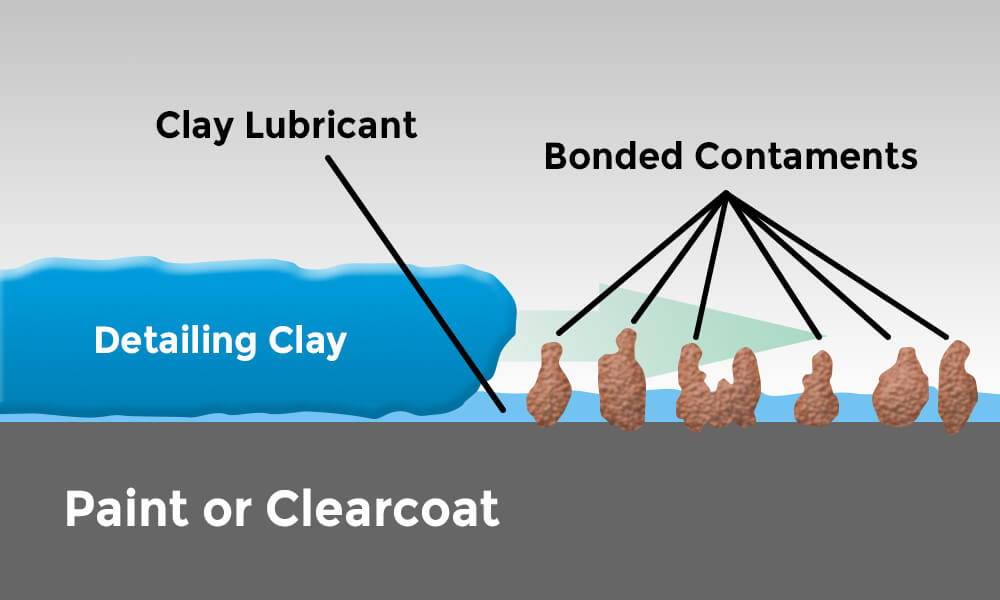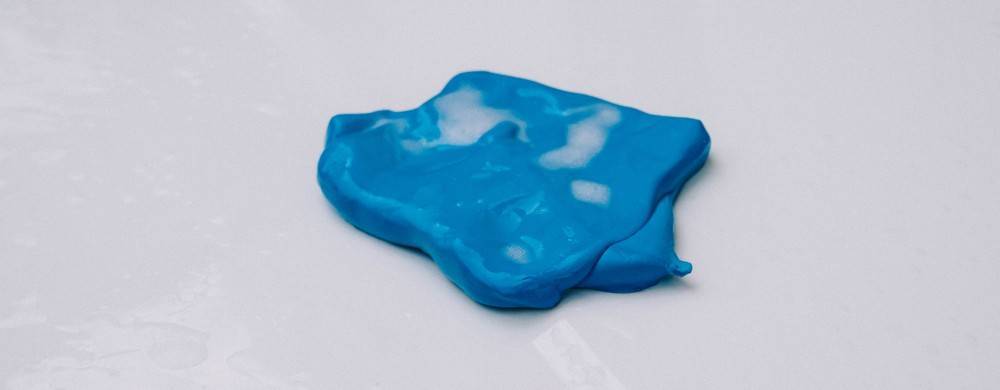One of the critical steps to a high-quality detailing procedure is surface decontamination. That’s the process of removing embedded dirt, chemical residue, mineral deposits, and other foreign elements from the paint of your vehicle.
Many owners think that washing their car with soap and a pressure washer will leave their paint perfectly clean. However, in reality, that’s not the case at all. There’s a good deal of dirt and contamination that’s lodged and hardened into the porous surface of the paint, and which is impossible to remove without either mechanical action or heavy-duty chemicals - sometimes both.
If these contaminants aren’t removed, they will compromise the quality and effectiveness of any subsequent procedure - be it polishing or ceramic coating - and shorten the lifespan of the vehicle’s paint.
Clay bars have risen as the standard tool for decontaminating automotive paint. Professionals and DIY enthusiasts alike have these in their arsenal - and you should too!
In this article, we’ll talk in detail about detailing clay bars, clay bar lube, and surface decontamination. Stick with us.
Your vehicle's surface is filled with contaminants. Some of these may be visible, such bug guts, bird droppings, water spots, and tree spots. And some contaminants, such as iron deposits, brake dust, and overspray may not be visible to the naked eye.
The Clay Decon Kit helps to remove that deepest layer of contaminants, that attaches to your vehicle's clear coat. This helps prevent long term damage to your clear coat.
The Basics: Understanding Clay Bars
A clay bar looks very similar to plasticine or Play-Doh - it’s a putty-like substance that can be moulded and formed easily into any desired shape.
You use a clay bar to rub over the panels of the vehicle and remove embedded contamination. The clay is slightly abrasive, so it shears off stuck chunks of dirt, road tar, brake dust, salts, mineral deposits, chemical residue, paint overspray, and other forms of contamination.
However, it’s soft enough so that, when used with a proper lubricant, it doesn’t
scratch the paint, leaving the surface finish mostly intact. Detailing clay is sticky, so loose contaminants get trapped inside it, and if a proper technique is used, it can’t come back on the paint.
Many of these elements will be removed in the washing process, but not all. Automotive paint and clear coats are fairly porous surfaces - they have small holes and cavities, just like your skin. Some contaminants will come in just the right particle size and shape to lodge firmly into these pores, making them impossible to remove with just soap and water.
First-timers are always amazed to see just how much dirt and grime detailing clay will pull out of the vehicle, even when it was thoroughly washed 5 minutes ago.
Detailing clay comes in all forms and shapes - there are wash mitts with integrated clay layers, clay blocks, clay mitts, clay sponges, and a host of other variants you can find online.
Some of these are convenient, but we can still argue that the original, putty-like clay is the best, most effective, and most versatile product on the market. It’s inexpensive, easily replaceable, and gets you practically the same quality when handled correctly. If you’re just starting out, stick with a regular clay bar for a while before exploring different products.
Claying a vehicle seems really simple from the side - just mindlessly rub it over until you’re satisfied with the effects. However, always remember that detailing clay is an abrasive. If you don’t use the proper technique, you can and will damage the surface finish of the vehicle, introducing marring, hazing, or even light scratches.
In the interest of fairness, the decontamination procedure may require some specialized chemical products like iron, road tar, and mineral deposit removers. These products attack specific groups of contaminants and are generally safe to use.
Before the invention of detailing clay, car care specialists used harsh chemicals - strong acids and bases - to dissolve the contaminants. These do work, but they’re very aggressive, and will attack the paint if left on for too long. Prolonged use will eventually thin out and deplete the clear coat and compromise the paint entirely.
These chemicals will also burn your skin, eyes, and lungs, so it’s always required to use proper personal protection - gloves, glasses, and a mask.
Harsh acids and bases are still used for severely contaminated vehicles - usually wheels caked in brake dust. However, they are to be avoided if possible.
Why A Clay Bar Lube Is Crucial
Above: A picture of Torque Detail's Decon Kit, including a clay lube and a clay bar block.
Don’t ever use a clay bar on a vehicle without lubrication! This is the quickest, surest method to ruin the paint and have to polish the entire panel - hopefully before the owner of the vehicle sees it.
If you try it on an old junkyard body panel, you’ll find that you can’t even rub it over easily. The clay will try to stick and catch - because that’s exactly what it’s designed to do.
In order to clay the vehicle, you must always, 100% of the time, use a clay lubricant!
The lubricant minimizes the friction between the clay and body panel, reducing the chances of scratching or marring the surface. It doesn’t reduce the effectiveness of the clay, because the contaminant particles have a rough and irregular surface and will catch on regardless.
Lube also helps you effortlessly move the piece of clay, allowing you to do a better job - faster, easier, and safer. Trust us, if you have to clay a whole vehicle - let alone a few in one day - you’ll appreciate the difference clay bar lube makes on your arms after the job is done.
But which clay lube to use? There are literally hundreds of products on the market, each claiming to be the best, most effective, and safest for the paint.
A ready-to-use solution will cost you around $20 for a half-gallon jug. That’s not too bad, so if you’re a beginner or are looking for a no-hassle solution, just buy one and don’t overthink it.
However, over time, you’ll find out you’re actually using this stuff a lot and the cost will start to pile up.
Here’s the thing: you don’t have to buy a ready-made clay lube. There are half a dozen homemade recipes that will work just fine and sometimes even better than the name brand ready-to-use products.
They’re also dirt cheap and super easy to make yourself, so let’s look into some clay lube alternatives and homemade concoctions.
Clay Lube Substitute: Is Water A Good Idea?
If you’re shopping for clay online, you may see some descriptions recommend using pure water as lubricant for the claying process.
Don’t do it! That’s never a good idea!
Water significantly reduces friction compared to running dry, but a lubricant it is not! The second you start putting some effort into the panel, you’ll begin marring and scratching the paint.
Water alone won’t do, but there’s a cheap and super effective additive to turn that water into a very decent clay lubricant: car soap.
Clay Lube Alternative: Is Car Soap A Good Idea?
Above: A picture of Decon Soap and Ceramic Car Shampoo.
Yes, soapy water makes a very decent clay lubricant! It’s by far the cheapest way to do it and you likely already have some in stock, so you can mix it up right now.
After you wash the car, mix the same proportions of car shampoo and water in a clean bucket or spray bottle and apply generously to the surface. Then, go at it with the clay, regularly adding more soapy water to keep the surface wet at all times.
Many car enthusiasts use soapy water as clay lube on a daily basis and will readily testify as to its lubricating properties.
Of course, while car soap can be an effective lubricant, not all are created equal. They contain different proportions of detergents that help dissolve different types of dirt, grease, oils, chemicals, and metals. The agents that break down these contaminants also wet and lubricate the surface, making soapy water a good medium for using detailing clay.
You can judge how slippery and slick the surface is with your bare hand. You should not, however, determine the lubricity of any given soap solution by the amount of foam it produces.
Foam is just air bubbles trapped in the water. It’s a by product of the soap agents, which lower the surface tension and allow solids and gasses to mix more easily with water. Foam has no cleaning or lubricating qualities in its own right and is not actually needed to clean at all - dishwasher and washing machine detergents clean absolutely fine without any foam or suds.
Foam is a marketing gimmick! In fact, many soap manufacturers add foaming agents because people associate foam with cleaning power, and judge the effectiveness of the product by the amount of foam it produces.
Car shampoo manufacturers know how delicate the paint is, so they also add small amounts of lubricants - cellulose or synthetic polymers - to help protect the paint during washing and preserve the condition of the finish for longer.
It’s this ingredient you should be most interested in if you’re planning to use car soap for clay lube. Of course, you don’t know how much there is in any given product, so you’re stuck to trying out a couple and analyzing how slippery the solution is on your body panels.
Most car shampoos are fine for the DIY enthusiast who wants to clay their own car and keep it looking brand new all the time. The low cost and ready availability is hard to beat.
However, you won’t see any professional detailer use car soap as clay lube on a client’s car. It’s okay, but not fantastic, and you should only really use it for light pressure claying. Any hard pressure will easily overcome the lubrication and potentially harm the finish.
There are better products you can use for your homemade clay lube.
Can You Use A Quick Detailer Spray As A Clay Lubricant?
Above: A picture of Turbo Waterless Detailer. A popular product for washing a car without water, keeping black cars clean, removing bird poop, and much more!
Yes, quick detail sprays are acceptable as well! Although, there are some considerations.
They are designed to go on dry surfaces or microfiber towels, so manufacturers add generous amounts of lubricating polymers. These work to both lubricate the surface and prevent marring and scratching, while also removing dirt by bonding freely with the particles and trapping them in the liquid medium.
Therefore, if you have a detailing spray in your arsenal already, you can use it as a clay bar lube straight on. It’s already in a spray bottle - there’s no mixing, no dilution, and no hassle. However, this convenience comes at a price.
At $20-$30 for a 16-24 oz. bottle, quick detailers are certainly more expensive than anything we’ve discussed so far. However, they’re also very safe and a good pick for beginners who are still learning the basics of clay bars and decontamination.
Quick detailers provide enough lubrication to go harder with your clay bar, although be aware that any hard claying will still eventually mar and dull the surface finish - especially on dark and black cars.
If you want to try one out, we suggest using our own formula - Torque Detail’s Turbo Waterless Detailer.
It contains a small amount of SiO2 ceramic particles, which remain after you’re done claying and fill in some of the cavities previously full of contaminants. Turbo Waterless Detailer makes the surface non-static and hydrophobic, making your job easier the next time around.
It’s good for touch-ups between washes, removing bird crap, boosting the longevity of your existing ceramic coating, and also as a clay lubricant.
Clay Bar Lubricant: Why It’s A Must
Finally, we get to the genuine stuff - ready-to-use clay spray lubricants. There’s a reason why this stuff exists - it’s the best for the job.
Professional clay lube comes as a ready-to-use product, meaning you can start the job immediately. It carries the right amount of lubricants and dissolving agents to complete a professional decontamination procedure.
Mixing soap and diluting ONR is fine for everyday use on your own cars and maybe the daily drivers of your customers. However, when it comes to detailing high-priced exotics, you don’t want to take any chances, even with simple things like what clay lube to use.
Imagine being hired to detail somebody’s Lambo only to add swirl marks all over the car because you mixed the wrong proportions, or the paint was soft and you didn’t have the necessary lubrication.
Using a professional spray lubricant removes all the human error elements in picking and matching the right product. This can make the price worth it.
Some clay bars and cleaning solutions aren’t compatible, and you can notice your clay degrading unusually quickly as a result. Typically, this isn’t too much of a problem if you use an ordinary clay bar. These are expandable and have to be thrown away, as they get saturated with dirt. You don’t want to use the same one a whole year until it turns black, since you’ll just be smearing the grime from old jobs onto new ones. Still, if your lube is eating through clay bars too quickly, especially more expensive products, that’s going to affect your bottom line cost.
Professional clay lube doesn’t do that. It’s designed specifically to work with clay, so you’ll get more life out of yours. Plus, at $20 for a gallon, it’s not exactly breaking the bank, even if it’s a single-purpose product.
If you’re aiming for a top-notch job, simply pay for a top-notch product. You can grab the whole decontamination kit from Torque Detail (clay bar kit + decon kit), containing a decon wash soap, mitt, clay pad, and lube - all for $50.
Your vehicle's surface is filled with contaminants. Some of these may be visible, such bug guts, bird droppings, water spots, and tree spots. And some contaminants, such as iron deposits, brake dust, and overspray may not be visible to the naked eye.
The Clay Decon Kit helps to remove that deepest layer of contaminants, that attaches to your vehicle's clear coat. This helps prevent long term damage to your clear coat.
Voilà, You Now Know All About Clay Bar Lube!
In summary, here’s everything you need to remember about clay bars and lubrication.
- Always wash your car first.
- Always use clay lubricants when you work with detailing clay.
- Water is not a clay lubricant! Don’t try it, you’ll scratch the finish.
- Car shampoo or soapy water is a decent clay lube and will work just fine for your daily driver. It costs a few pennies to mix and is readily available. Just be careful not to exert too much pressure on the clay - soapy water might not be able to handle it.
- A bottle of diluted Optimum No Rinse is one of the best products you can conjure yourself. It’s very cheap, super versatile, and offers great lubrication for your clay bar. Professional detailers swear by this product, so definitely give it a try.
- Quick detailer sprays are a step up. If you have one, you can readily use it as clay lube. Quick detailers offer more lubrication, but also cost considerably more.
- Professional clay lube products are undisputedly the best, safest, and most hassle-free products. If you’re working on expensive cars, our advice is this: don’t risk it. Pay for a quality product.
There we go - everything there is to know about clay lube, from the garage chemistry to the professional stuff! You’re now fully tuned in and can choose your products with confidence.







